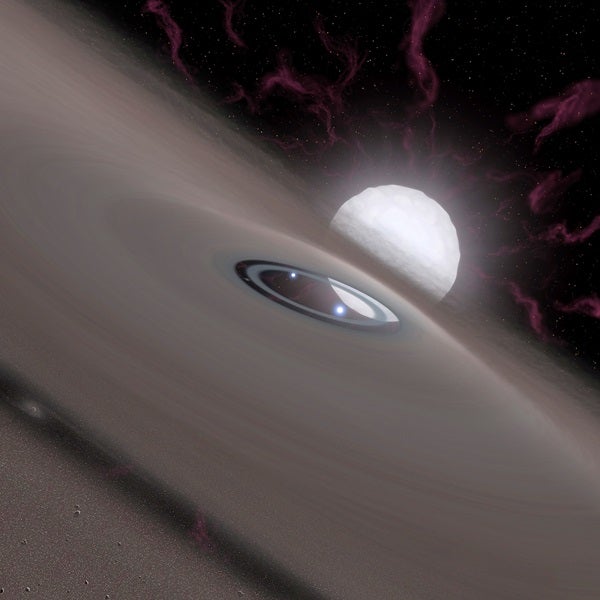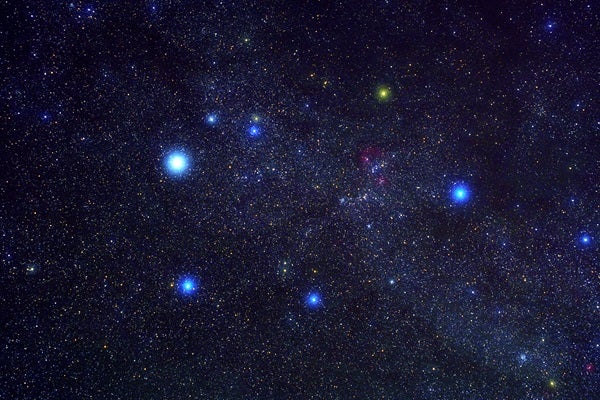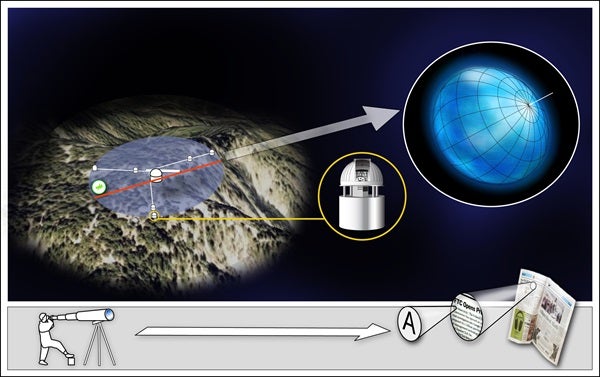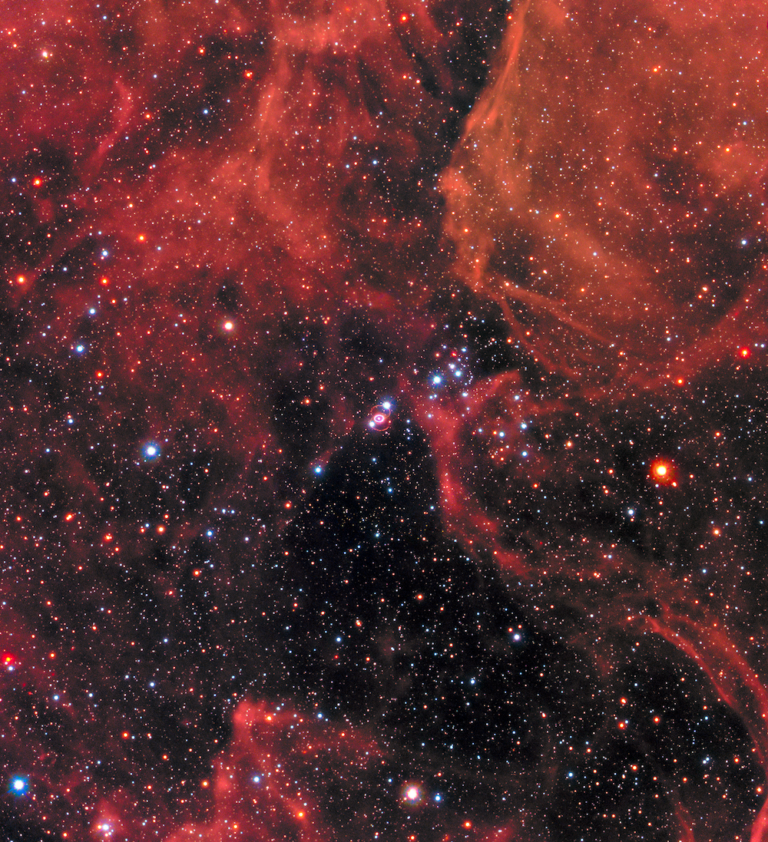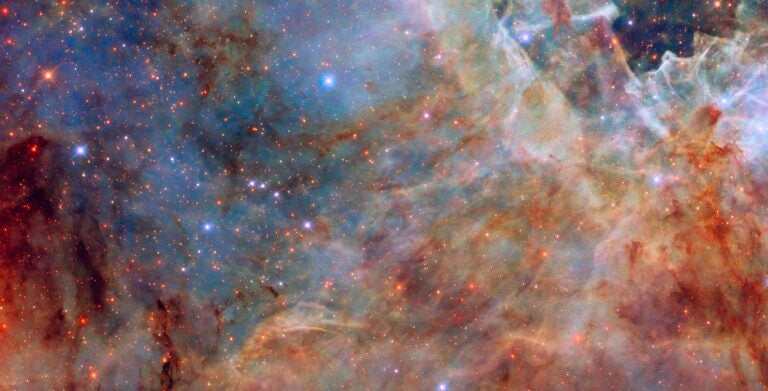This originally appeared in our October 2009 issue.
A celestial sleight-of-hand is underway. The bright star Epsilon (ε) Aurigae began to dim this summer. Bit by bit, it will darken by almost a full magnitude on the astronomical brightness scale, becoming 2.5 times dimmer. Then it will languish at this shadowed state for the next year or more before slowly returning to its normal brilliance in the constellation Auriga the Charioteer.
Astronomers strongly suspect the dimming is some sort of eclipse event, in which an orbiting companion periodically passes in front of Epsilon Aurigae and blocks a portion of its light. Since 1821, astronomers ahve seen the star fade 7 times, every 27 years or so. And yet, as predictable as these eclipses have been, the underlying cause remains one of the oldest mysteries of modern astronomy.
The physical nature of the object that eclipses Epsilon Aurigae remains unknown. To produce such long eclipses, the obscuring object must be incredibly large — large enough that if it were placed at the center of our solar system, its surface would reach almost to the orbit of Uranus.
Further complicating matters, the eclipsing body does not appear to obscure Epsilon Aurigae entirely. Throughout the eclipse, a portion of Epsilon Aurigae’s light remains visible, as if the object obscuring it either doesn’t cover it entirely or covers it like the lenses in a pair of sunglasses — evenly blocking out a certain percentage of light at every wavelength but letting the rest through.
With each eclipse, a new generation of astro-nomers has attacked this mystery, coming at it each time with a new set of instruments. Yet, each time the new knowledge has only deepened the mystery. As astronomer Otto Struve wrote in 1962, “The history of the eclipsing binary Epsilon Aurigae is in many respects the history of astrophysics.”
And now that history is about to get a new chapter. Modern telescope technology should provide the sharpest and most detailed views of the Epsilon Aurigae system ever. Combined with measurements of the star’s dimming cycle collected by dedicated amateur observers, the latest eclipse may finally unmask the secrets of one of astronomy’s longest-running mystery shows.
The early observers
Epsilon Aurigae is a white supergiant star visible to the naked eye under moderately dark sky conditions. In 1821, German pastor and amateur astronomer Johann Fritsch noticed that Epsilon Aurigae had dimmed by a magnitude for about a year and then returned to its previous brightness. When the star dimmed again in 1848, and then again in 1876, astronomers realized they had something unusual on their hands.
The dimmings had occurred about 27 years apart. To modern astronomers, this would suggest a type of star system called an eclipsing binary, in which one of a pair of mutually orbiting suns periodically passes in front of the other, cutting off some or all of its light. To a distant observer, an eclipsing binary looks like a single star that shines steadily between periodic dips in brightness.
Nineteenth-century astronomers, however, labeled Epsilon Aurigae an “irregular variable” — a lone star changing in brightness. “Binary star theory just wasn’t that developed in the 19th century,” explains Robert Stencel of the University of Denver. Astronomers then were more familiar with variable stars and chose that phenomenon as their preferred explanation.
In 1903, the star dimmed a fourth time, precisely on schedule. Astronomers observed this one closely and found the star going through a slow 6-month decline in brightness, followed by a year-long flat minimum, and ending with a slow 6-month return to full brightness. It was then that astronomers finally realized for certain that this was not an irregular variable, but a strange and inexplicable eclipsing binary.
The length of the 1903 eclipse — the longest measured to date — left astronomers puzzled. Based on Epsilon Aurigae’s estimated distance of about 2,000 light-years, only a truly immense object would be able to produce a 2-year-long eclipse. Scientists estimated its radius as 3,000 times that of the Sun, making it by far the largest stellar-type object they knew of at the time.
The 1903 eclipse was also the first observed with the aid of spectroscopy. Splitting Epsilon Aurigae’s light into its component wavelengths (colors) revealed new mysteries about the unseen eclipsing body. During the entire eclipse, Epsilon Aurigae’s spectrum of colors did not change. All the invisible companion did was dim the light of the visible star equally across all wavelengths, much as a pair of sunglasses diminishes the brightness of a sunny day.
In addition, the eclipsing companion produced no visible spectral signature of its own, so it was completely dark. The 1928–1930 and 1955–1957 eclipses only confirmed the observations and deepened the enigma.
Astronomers were baffled. What was the nature of the eclipsing companion in the Epsilon Aurigae system? By the middle of the 20th century, they had arrived at a range of solutions, all of which were exotic but none very satisfying.
In 1924, German astronomer Hans Ludendorff proposed that a dense swarm of meteoroids orbiting the visible star causes the eclipses. Gerard Kuiper, Otto Struve, and Bengt Strömgren of the Yerkes Observatory topped Ludendorff in 1937. They speculated that the eclipsing companion is invisible because it emits its radiation entirely in the infrared. The radiation produces a gigantic solar-system-sized cloud of charged particles — an ionosphere — around the star. This ionosphere acts as a filter that blocks the visible companion star’s light during the eclipse.
In 1955, Struve proposed that Epsilon Aurigae consists of an eclipsing binary encircled by a complex of gas clouds. The clouds are thick enough to block our view of the eclipsing star while also partly obscuring the light of the visible star.
Data from the 1955–1957 and 1982–1984 eclipses helped astronomers significantly refine this theory, while also serving to confuse them further. For example, some observations of the 1982–1984 eclipse suggested that the dark companion is a disk that, as it passes in front of the bright star, cuts across its face diagonally. Moreover, the light from the star actually increased by almost two-tenths of a magnitude during the middle of the eclipse, suggesting that this disk is not only semitransparent — but it also has a hole in its center, like a doughnut!
One leading model proposes that the dark companion is a large disk of dust and gas swirling around a single relatively dim star. In this model, the visible star is thought to weigh about 15 solar masses, while the combined weight of the disk and its dim star is 13.7 solar masses.
From Earth, we see the disk system nearly edge-on. The disk’s estimated diameter is 1.7 billion miles (2.7 billion kilometers), which is almost the size of Uranus’ orbit. This theory is especially intriguing because it suggests that the eclipsing object may be a protoplanetary disk — a solar system in the making.
Explanations of Epsilon Aurigae’s behavior grew more complicated with further observations. During the 1955–1957 eclipse, the dimming and brightening phases bracketing the eclipse lasted a little more than 4 months each — shorter than in previous eclipses.
Also, the duration of Epsilon Aurigae’s minimum brightness, or “totality,” was unusually long — about 13 months. Then, the 1982–1984 eclipse accelerated this trend: Totality lasted 15 months, and the final brightening took only 2 months. The findings implied that something in the system was changing.
In 1985, Peter Eggleton, now at Lawrence Livermore National Laboratory in California, and James Pringle of the Institute of Astronomy at the University of Cambridge, England, proposed a new explanation for the observed changes in eclipse timing. For one thing, the researchers downgraded the overall mass of the system. The visible star in their model comes in at only 1.5 to 2.5 solar masses. The disk eclipsing the visible star weighs in at about 5 solar masses and harbors a central pair of stars orbiting each other at a close distance.
Eggleton and Pringle proposed that the visible star is evolving from a red giant to a white dwarf. Over the next 10,000 years, the star will end up as a white dwarf star nestled within shells of gas cast off earlier in its aging process, forming a planetary nebula. As these changes happen, the star actually shrinks, which in turn changes the shape and size of the surrounding cloud. That could explain the changes in the length of totality and the dimming and brightening phases.
In fact, some observations confirm Eggleton and Pringle’s story. In October 1977 — between eclipses — astronomers from the University of Tokyo and Kyoto University in Japan detected a sudden change in the radial velocities of the visible star’s atmosphere. It was as if the star’s outer layers had suddenly experienced a violent and sudden collapse. Additional spectrographic data from the 1982–1984 eclipse also suggested that the system’s mass fits the lower numbers of the Eggleton-Pringle hypothesis.
On the other hand, unknown changes taking place in the eclipsing disk rather than the visible star could account for the shifts in timing. “Clearly some trend, some phenomenon, is underway,” Stencel notes. And it’s happening “on a time scale of decades rather than centuries or millions of years.” That means the current eclipse will likely not follow its previous schedule and could hold some new surprises for astronomers.
The latest eclipse will be like all the others in one respect: Astronomers will attack it with a new and more powerful generation of technology. This includes, of course, the fleet of modern space observatories such as the Hubble Space Telescope, the Spitzer Space Telescope, and the Chandra X-ray Observatory. All will turn their eyes on Epsilon Aurigae repeatedly.
Of the new detectors, however, possibly the most intriguing are interferometers, which combine the light of multiple ground-based telescopes to enhance their ability to resolve fine details. One such interferometer is an array of six 1-meter telescopes at Mount Wilson in California, which is operated by the Center for High Angular Resolution Astronomy (CHARA) of Georgia State University.
Observing in infrared, the CHARA array produces images with a resolution equivalent to a single telescope with a mirror 820 feet (250m) in diameter. “At this resolution, you could read a newspaper at 100 miles [160 km],” explains John Monnier of the University of Michigan, a frequent user of the CHARA array.
Because there are many ways one can combine the light from CHARA’s telescope array, a number of other institutions have developed instruments for it, working in collaboration with Georgia State University. For example, astronomers from the University of Michigan used their Michigan Infrared Combiner (MIRC) to overlay the light from four of CHARA’s telescopes to produce the array’s first images.
CHARA’s spectacular feats have included imaging the surface of several stars and binary systems, such as the rapidly rotating and distorted stars Alderamin and Altair and the mass-exchanging close binary Beta Lyrae. The images of Beta Lyrae are especially dazzling because they show the two stars orbiting each other as well as the gaseous material streaming between them.
CHARA’s resolution using MIRC should be able to produce an image of Epsilon Aurigae’s eclipsing disk as it transits the face of the star in the current eclipse. “Epsilon Aurigae is an ideal target for us,” Monnier says.
The plan is to take a baseline image during the beginning of the eclipse. If the invisible object has a sharp edge and can therefore be imaged, they then will follow up with repeated observations during the entire eclipse.
Citizen scientists
Even as professional astronomers are attacking the problem with the latest technology, amateurs also have an important part to play. For example, since the last eclipse from 1982–1984, retired engineer Jeffrey Hopkins has used his privately built amateur observatory in Arizona to monitor the star. “Jeff is not separately funded for the effort. He does it basically as a hobby,” Stencel notes. “Yet I believe his work is professional grade. And you can’t beat the persistence factor in his case.”
Astronomers hope that other amateurs will join in, monitoring the star daily and tracking its changes in brightness before, during, and after the eclipse. “Weather patterns and time-of-year factors might make it difficult for Jeff to get a complete light curve,” explains Stencel. “But if we have people in Canada or Finland watching this thing during high summer, they might be able to help us fill in some blanks.” (Epsilon Aurigae’s celestial position makes it unobservable at southern latitudes.)
The U.S. component of the International Year of Astronomy 2009 has targeted Epsilon Aurigae for a “citizen scientist” campaign, coordinated by the American Association of Variable Star Observers. Non-professional observers can measure Epsilon Aurigae’s brightness telescopically, either with visual methods or using electronic detectors. Those observations will become part of the body of scientific data that astronomers will use to study Epsilon Aurigae.
Hopefully, by the time the eclipse ends in 2011, many gaps will be filled in, and researchers will finally unveil the solution to one of astronomy’s most enduring mystery shows. If not, there will always be the next chapter to this story, set to start again sometime around 2046.

